企业文化-企业文化建设英文 精品
公司企业文化英文作文
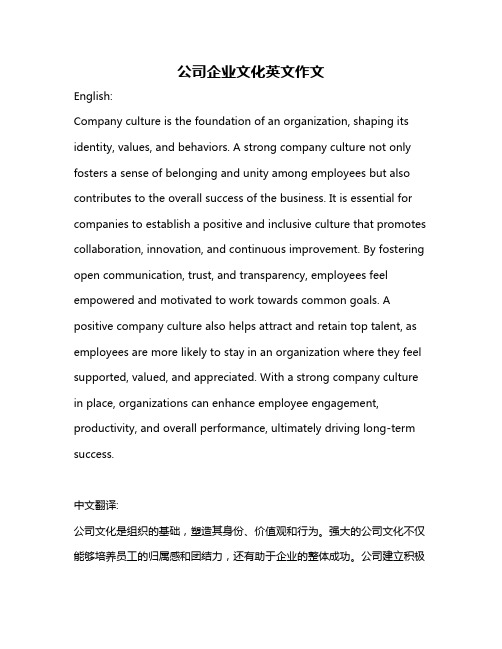
公司企业文化英文作文English:Company culture is the foundation of an organization, shaping its identity, values, and behaviors. A strong company culture not only fosters a sense of belonging and unity among employees but also contributes to the overall success of the business. It is essential for companies to establish a positive and inclusive culture that promotes collaboration, innovation, and continuous improvement. By fostering open communication, trust, and transparency, employees feel empowered and motivated to work towards common goals. A positive company culture also helps attract and retain top talent, as employees are more likely to stay in an organization where they feel supported, valued, and appreciated. With a strong company culture in place, organizations can enhance employee engagement, productivity, and overall performance, ultimately driving long-term success.中文翻译:公司文化是组织的基础,塑造其身份、价值观和行为。
企业文化建设 英文文献
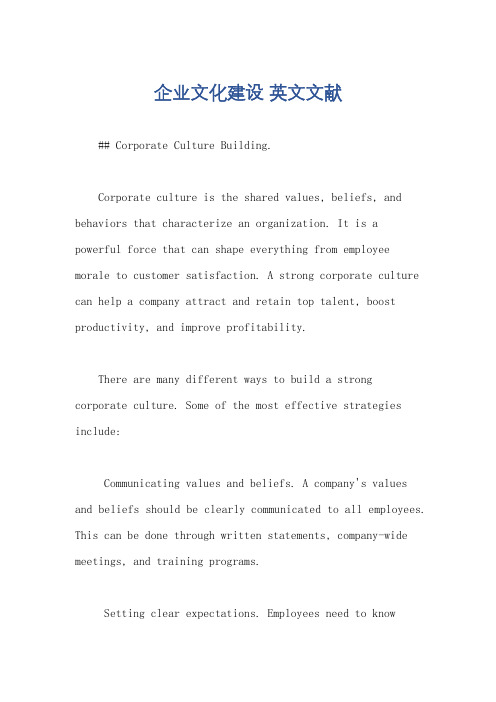
企业文化建设英文文献## Corporate Culture Building.Corporate culture is the shared values, beliefs, and behaviors that characterize an organization. It is a powerful force that can shape everything from employee morale to customer satisfaction. A strong corporate culture can help a company attract and retain top talent, boost productivity, and improve profitability.There are many different ways to build a strong corporate culture. Some of the most effective strategies include:Communicating values and beliefs. A company's values and beliefs should be clearly communicated to all employees. This can be done through written statements, company-wide meetings, and training programs.Setting clear expectations. Employees need to knowwhat is expected of them in terms of behavior and performance. Clear expectations help to create a consistent work environment and reduce confusion and uncertainty.Rewarding desired behaviors. When employees demonstrate desired behaviors, it is important to reward them. This can be done through bonuses, promotions, or simply verbal praise.Creating opportunities for learning and development. Employees need to have opportunities to learn and develop their skills. This can be done through training programs, workshops, and on-the-job training.Fostering a sense of community. A strong corporate culture is built on a sense of community. Employees need to feel like they are part of something bigger than themselves. This can be fostered through team-building activities, company events, and social media.Building a strong corporate culture takes time and effort. However, the benefits are well worth it. A strongcorporate culture can help a company attract and retain top talent, boost productivity, and improve profitability.## 企业文化建设。
企业文化标语中英文
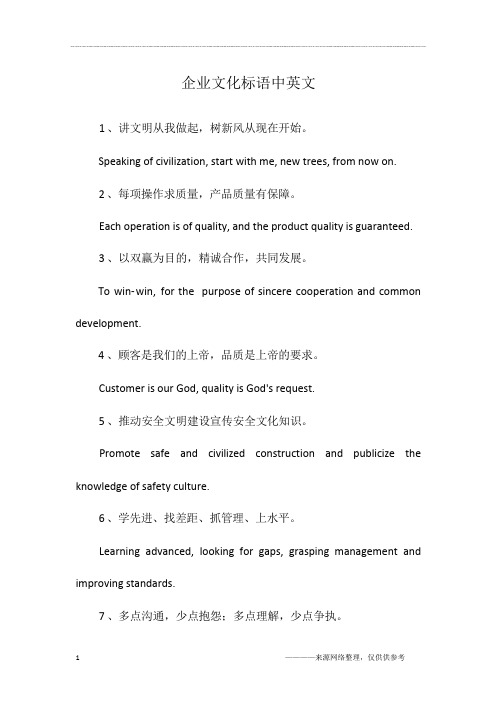
企业文化标语中英文1 、讲文明从我做起,树新风从现在开始。
Speaking of civilization, start with me, new trees, from now on.2 、每项操作求质量,产品质量有保障。
Each operation is of quality, and the product quality is guaranteed.3 、以双赢为目的,精诚合作,共同发展。
To win-win, for the purpose of sincere cooperation and common development.4 、顾客是我们的上帝,品质是上帝的要求。
Customer is our God, quality is God's request.5 、推动安全文明建设宣传安全文化知识。
Promote safe and civilized construction and publicize the knowledge of safety culture.6 、学先进、找差距、抓管理、上水平。
Learning advanced, looking for gaps, grasping management and improving standards.7 、多点沟通,少点抱怨;多点理解,少点争执。
More communication, less complaints, more understanding, less dispute.8 、自主检验做的好,生产顺畅不得了。
Independent inspection done well, production smoothly.9 、手连手,发扬优质精神。
Hand in hand, to carry forward the spirit of quality.10 、质量是帆,企业是船,帆落船停帆鼓船进。
Quality is a sail, a business is a ship, a sail is down, a ship is sailing, a ship is sailing.11 、用我们行动连接你我他。
英文企业文化标语
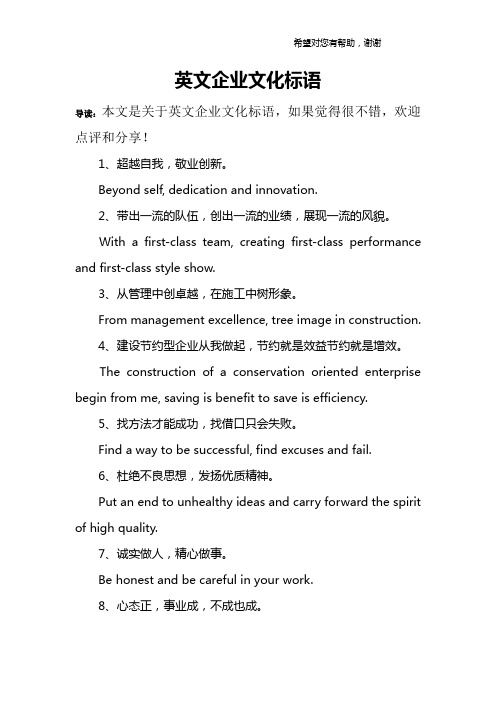
英文企业文化标语导读:本文是关于英文企业文化标语,如果觉得很不错,欢迎点评和分享!1、超越自我,敬业创新。
Beyond self, dedication and innovation.2、带出一流的队伍,创出一流的业绩,展现一流的风貌。
With a first-class team, creating first-class performance and first-class style show.3、从管理中创卓越,在施工中树形象。
From management excellence, tree image in construction.4、建设节约型企业从我做起,节约就是效益节约就是增效。
The construction of a conservation oriented enterprise begin from me, saving is benefit to save is efficiency.5、找方法才能成功,找借口只会失败。
Find a way to be successful, find excuses and fail.6、杜绝不良思想,发扬优质精神。
Put an end to unhealthy ideas and carry forward the spirit of high quality.7、诚实做人,精心做事。
Be honest and be careful in your work.8、心态正,事业成,不成也成。
The mind is positive, the career becomes, the success is not.9、质量是企业的生命,安全是职工的生命。
Quality is the life of enterprise, is the worker's life safety.10、一丝之差,优劣分家。
Separation of advantages and disadvantages.11、关爱生命,保护环境,预防为主,持续改进。
企业文化英语介绍范文

企业文化英语介绍范文Corporate culture is the unique set of values, beliefs, and behaviors that define the identity of an organization. It serves as the foundation for how employees interact with each other, as well as how they engage with customers and the broader community. A strong corporate culture can help drive employee satisfaction, productivity, and overall success.At our company, we take great pride in our corporate culture, which is built on the following key principles:1. Respect and Integrity: We believe in treating all individuals with respect, honesty, and integrity. This means fostering an inclusive and supportive work environment where everyone is valued for their unique contributions.2. Collaboration and Teamwork: We emphasize the importance of collaboration and teamwork in achieving our goals. We encourage open communication, idea sharing, and mutual support among team members.3. Innovation and Creativity: We embrace innovation and creativity as essential components of our success. We encourage employees to think outside the box, experiment with new ideas, and continuously improve our products and services.4. Customer Focus: We are committed to putting our customers at the center of everything we do. We strive to exceed their expectations, anticipate their needs, and provide exceptional service at every touchpoint.5. Continuous Learning and Development: We believe in the importance of continuous learning and development for our employees. We provide opportunities for training, mentorship, and professional growth to help our team members reach their full potential.6. Social Responsibility: We are dedicated to being responsible corporate citizens, both in our local communities and on a global scale. We support environmentalsustainability, social causes, and ethical business practices.7. Work-Life Balance: We understand the importance of work-life balance in maintaining employee well-being and satisfaction. We offer flexible work arrangements, wellness programs, and other resources to support our team members in achieving a healthy balance.Overall, our corporate culture is a reflection of who we are as an organization and what we stand for. It is the driving force behind our success and the reason why employees choose to work with us. We are committed to upholding these core values and principles in everything we do, and we believe that they will continue to guide us towards a bright and prosperous future.。
中英文企业文化
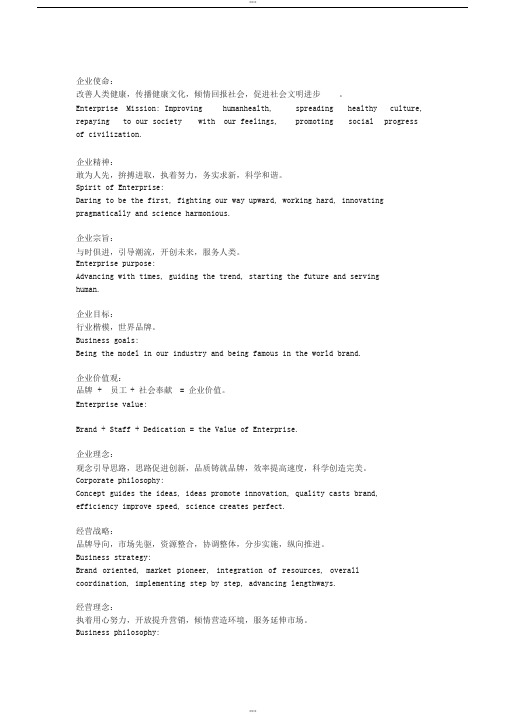
企业使命:改善人类健康,传播健康文化,倾情回报社会,促进社会文明进步。
Enterprise Mission: Improving humanhealth, spreading healthy culture, repaying to our society with our feelings, promoting social progress of civilization.企业精神:敢为人先,拚搏进取,执着努力,务实求新,科学和谐。
Spirit of Enterprise:Daring to be the first, fighting our way upward, working hard, innovating pragmatically and science harmonious.企业宗旨:与时俱进,引导潮流,开创未来,服务人类。
Enterprise purpose:Advancing with times, guiding the trend, starting the future and servinghuman.企业目标:行业楷模,世界品牌。
Business goals:Being the model in our industry and being famous in the world brand.企业价值观:品牌 + 员工+ 社会奉献= 企业价值。
Enterprise value:Brand + Staff + Dedication = the Value of Enterprise.企业理念:观念引导思路,思路促进创新,品质铸就品牌,效率提高速度,科学创造完美。
Corporate philosophy:Concept guides the ideas, ideas promote innovation, quality casts brand,efficiency improve speed, science creates perfect.经营战略:品牌导向,市场先驱,资源整合,协调整体,分步实施,纵向推进。
英文版 企业文化
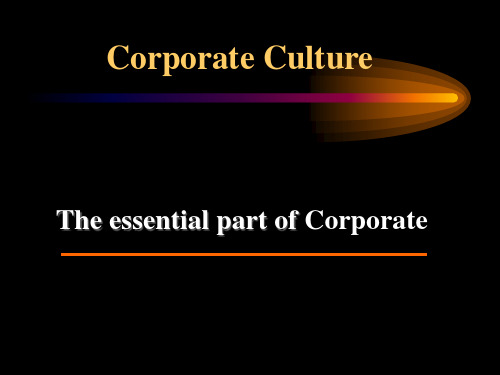
1. the strongman culture, This culture enco ura ges int e rnal co m peti tio n a n d innovation, encourages risk-taking. 2. Work hard to enjoy culture ,This culture to both work and play, and encouraging employees to complete a less risky job. 3. Bet-type culture, It has features in a detailed analysis based on the desperate. 4. Process-type culture. This culture, focusing on how to do basic work feedback, employees are difficult to measure the work they do.
2.Constraint Functions Constraint functions of the corporate culture is through the improvement of management systems and ethics. Constraint functions is reflected in the following two aspects ,that is E f f e c t i v e r e g u l a t o r y constraints, Ethics constrainulture
Deal and Kennedy thought that corporate culture was an overview of the theoretical system for the five elements, namely, business environment, values, heroes, cultural ceremonies and cultural network.
如何建设企业文化英语作文
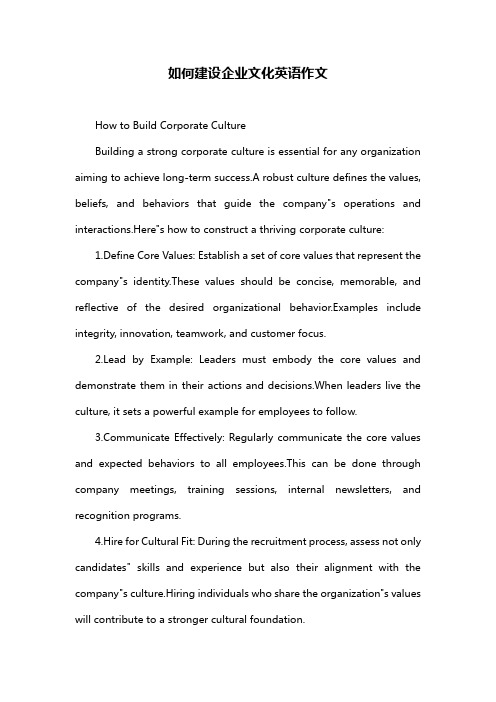
如何建设企业文化英语作文How to Build Corporate CultureBuilding a strong corporate culture is essential for any organization aiming to achieve long-term success.A robust culture defines the values, beliefs, and behaviors that guide the company"s operations and interactions.Here"s how to construct a thriving corporate culture:1.Define Core Values: Establish a set of core values that represent the company"s identity.These values should be concise, memorable, and reflective of the desired organizational behavior.Examples include integrity, innovation, teamwork, and customer focus.2.Lead by Example: Leaders must embody the core values and demonstrate them in their actions and decisions.When leaders live the culture, it sets a powerful example for employees to follow.municate Effectively: Regularly communicate the core values and expected behaviors to all employees.This can be done through company meetings, training sessions, internal newsletters, and recognition programs.4.Hire for Cultural Fit: During the recruitment process, assess not only candidates" skills and experience but also their alignment with the company"s culture.Hiring individuals who share the organization"s values will contribute to a stronger cultural foundation.5.Encourage Collaboration: Foster an environment where teamwork is encouraged and rewarded.Collaboration helps build a sense of unity and shared purpose among employees, reinforcing the company"s culture.6.Provide Training and Development: Invest in training programs that help employees understand and live the company"s culture.Offer continuous development opportunities to ensure employees grow both personally and professionally within the cultural framework.7.Recognize and Reward: Acknowledge individuals and teams who exemplify the desired behaviors and contribute to the company"s culture.Recognition can take the form of rewards, public praise, or other meaningful gestures.8.Address Cultural Issues: Promptly address any cultural issues or conflicts that arise.Ignoring such problems can lead to a toxic work environment and erode the culture you"ve worked to build.9.Evolve and Adapt: As the company grows and evolves, its culture may need to adapt.Be open to feedback and make necessary adjustments to ensure the culture remains aligned with the organization"s goals and values.10.Measure and Assess: Regularly assess the effectiveness of your corporate culture through employee surveys, performance reviews, and other e this data to make informed decisions and continuouslyimprove the culture.By following these steps, organizations can build a strong corporate culture that not only attracts top talent but also promotes employee engagement, enhances productivity, and drives overall success.如何建设企业文化建设强大的企业文化对于任何追求长期成功的组织都至关重要。
公司企业文化宣传用语中英文
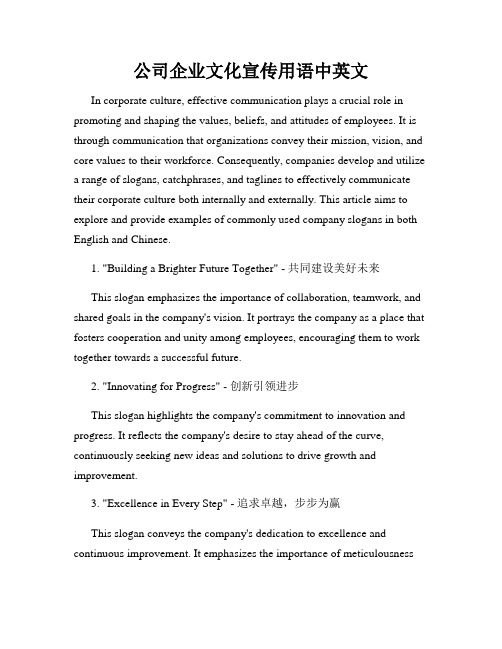
公司企业文化宣传用语中英文In corporate culture, effective communication plays a crucial role in promoting and shaping the values, beliefs, and attitudes of employees. It is through communication that organizations convey their mission, vision, and core values to their workforce. Consequently, companies develop and utilize a range of slogans, catchphrases, and taglines to effectively communicate their corporate culture both internally and externally. This article aims to explore and provide examples of commonly used company slogans in both English and Chinese.1. "Building a Brighter Future Together" - 共同建设美好未来This slogan emphasizes the importance of collaboration, teamwork, and shared goals in the company's vision. It portrays the company as a place that fosters cooperation and unity among employees, encouraging them to work together towards a successful future.2. "Innovating for Progress" - 创新引领进步This slogan highlights the company's commitment to innovation and progress. It reflects the company's desire to stay ahead of the curve, continuously seeking new ideas and solutions to drive growth and improvement.3. "Excellence in Every Step" - 追求卓越,步步为赢This slogan conveys the company's dedication to excellence and continuous improvement. It emphasizes the importance of meticulousnessand attention to detail in every aspect of the company's operations, encouraging employees to always strive for excellence.4. "Customer-centric, Always" - 客户至上,始终如一This slogan emphasizes the company's customer-centric approach and focus on providing exceptional customer experiences. It sends a message to employees, reminding them of the importance of putting customers at the center of everything they do.5. "Embracing Diversity, Embracing Success" - 拥抱多样性,取得成功This slogan highlights the company's commitment to embracing diversity in its workforce and fostering an inclusive environment. It conveys the message that diverse perspectives and backgrounds contribute to the company's success.6. "Taking Responsibility, Building Trust" - 承担责任,建立信任This slogan underscores the company's emphasis on accountability and trust. It communicates the company's commitment to taking responsibility for its actions and building trust with both employees and stakeholders.7. "Leading with Integrity" - 诚信领航This slogan emphasizes the company's commitment to conducting business with integrity and ethical standards. It aims to inspire trust and confidence among employees, customers, and partners.8. "Empowering Employees for Success" - 赋能员工,共创辉煌This slogan highlights the company's focus on empowering employees by providing them with the necessary tools, resources, and opportunities for personal and professional growth. It reflects the company's belief in the potential and value of its employees.9. "Creating a Sustainable Future" - 创造可持续的未来This slogan showcases the company's commitment to sustainability and responsible business practices. By emphasizing the importance of environmental and social responsibility, the company aims to contribute to a better and more sustainable future.10. "Together, We Achieve Greatness" - 携手共进,创造伟业This slogan promotes unity and teamwork within the company. It conveys the message that by working together, employees can achieve extraordinary results and make a significant impact.In conclusion, effective corporate culture communication is vital for organizations to align their employees with their values and goals. Through slogans and catchphrases, companies can succinctly convey their vision, mission, and core values both internally and externally. These examples of company slogans in both English and Chinese demonstrate the importance of clear and compelling communication in promoting and enhancing corporate culture.。
企业文化建设中英文

警句20条:(1)关心我们的工厂,就是关心我们自己。
Caring about our factory is caring about ourselves.(2)团队精神是完成工作的基础。
Teamwork is the basis of work.(3)产品就是人品,诚信铸就未来。
Product represents the character, integrity creates the future.(4)不为失败找借口,只为成功找方法。
No excuse for failure, but the solution for success.(5)生产任务要完成,安全事故要杜绝。
Completing production tasks with eliminating incidents.(6)每一天都是安全日,每一名员工都是安全员。
Every day is safety day, every employee is safety supervisor.(7)从我做起,保证品质。
Start from me to ensure quality.(8)下道工序就是客户。
The next process is for customer.(9)控制每一道工序,做好每一件产品。
Control each process, and ensure each product well done.(10)5S不只是口号,更需要全员实践。
5S is not only a slogan, but also needs to fully practice.(11)把握安全,拥有明天。
Hold safety, hold tomorrow.(12)每个问题都是一个金矿或宝藏。
Each problem is a gold mine or treasure.(13)创造最大价值回报社会。
Create the greatest value to return to society.(14)零缺陷的产品源于细节。
企业文化用语英文翻译标准文本

企业文化用语英文翻译标准文本一、理念体系部分1、 追求全球技术领先,实现宗申精良制造;We pursue global leadership in technology and lean manufacturing.2、 实现个人、企业、社会的和谐发展;We value the harmony among the individual, business and society.3、 求真务实,科学创新;Our business is driven by integrity and innovation.4、敬业、拼搏、创新;Devotion, Profession and Innovation5、生产组织最优化、制造价值最大化;Optimize the organization of production;Maximize the value of manufacturing.6、终结组装旧模式、开启制造新时代Terminate the old mode of assembling, initiate a new era of manufacturing.7、制造理念Manufacture philosophy精良制造,制造精品;Lean manufacturing makes excellent products.8.国际合作 精良制造International cooperation brings lean manufacturing9、把好质量每一道关;Quality comes from the care of details.10、要经营企业、先经营团队Before managing your business, manage your people first.11、质量铸就品牌、服务赢得市场Brand is created by quality, market is gained by service.12 心存壮志建百年企业、脚踏实地树一流品牌心存壮志建百年企业、脚踏实地树一流品牌Make a centennial Zongshen and world-class brands.13、过程定成败,结果论英雄;Success is achieved in the process but a winner is judged by results.14、细节决定成败,过程决定结果。
企业文化建设 英文参考文献

企业文化建设英文参考文献IntroductionCorporate culture refers to the collective values, beliefs, goals, and practices that shape the behavior and perception of an organization. It is one of the critical elements that differentiate one organization from the other. Culture has a significant impact on every aspect of an organization, such as employee engagement, productivity, and overall performance. Therefore, it is essential to develop a positive culture that aligns with the organization's goals and values. Effective corporate culture building requires a commitment at all levels of the organization, from top management to front-line employees. This paper provides a comprehensive review of significant works on corporate culture building.Impact of corporate cultureCorporate culture has a significant impact on the employees' behavior and the achievement of organizational goals. It provides a framework that guides the individual and collective decisions, behaviors, and perceptions of employees. Schumacher (2018) argues that corporate culture is the driving force behindhigh-performance organizations. He further argues that effective corporate culture-building practices create a sense of belonging, loyalty, and commitment among employees, which leads toincreased productivity and performance. This assertion is supported by the work of Denison (2012), who established through empirical research that corporate culture has a significant impact on organizational performance.Characteristics of effective corporate cultureAn effective corporate culture should be aligned with the organization's goals, values, and mission. Baker (2017) argues that culture should be designed to support the organization's strategy. In other words, culture should be purpose-driven. An effective culture should embody the principles of transparency, accountability, and fairness. A culture that promotes inclusivity and diversity leads to better organizational performance. Additionally, a culture that encourages open communication, collaboration, and innovation fosters an environment that nurtures ideas and promotes creativity.How to build corporate cultureBuilding an effective corporate culture requires a deliberate and systematic approach. The process should start with the identification of the organization's goals, values, and mission. This process should involve all stakeholders, including top management, employees, and external stakeholders such as customers. The next step is to define the cultural principles that align with the organizational goals and values. These cultural principles should be clearly stated and communicated to allstakeholders. It is essential to create a culture that allows for innovation, experimentation, and continuous learning.Leadership plays a critical role in shaping the corporate culture. Leaders should embody the cultural principles and lead by example. Leaders should inspire, motivate, and engage employees to embrace the culture. It is critical to establish a reward and recognition system that reinforces the cultural principles. Rewarding employees who embody the cultural values creates a sense of ownership, loyalty, and commitment.ConclusionEffective corporate culture-building practices are critical for defining the organization's identity, values, and mission. Corporate culture shapes the individual and collective behavior, perceptions, and decisions of employees. An effective corporate culture should be aligned with the organization's values and goals. Creating a positive culture that supports inclusivity, diversity, and innovation can lead to increased employee engagement, productivity, and organizational performance. Effective corporate culture building requires a commitment from all stakeholders, including top management, employees, and customers. It is critical to establish a deliberate and systematic approach to building the culture, which involves identifying the cultural principles, communicating them, and establishing a reward and recognition system that reinforces them. Leadership plays a critical role in shaping the corporate culture. Therefore, leadersshould embody the cultural principles and lead by example. Building a strong and positive corporate culture requires continuous effort and commitment.ReferencesBaker, R. (2017). The role of culture in generating and sustaining high performance. Journal of Organizational Culture, Communications, and Conflict, 21(1), 14-29.Denison, D. (2012). Corporate culture and organizational effectiveness. New York: Wiley.Schumacher, C. (2018). Building the performance culture: A systematic approach to driving organizational success. New Jersey: John Wiley & Sons.。
企业文化英文怎么说
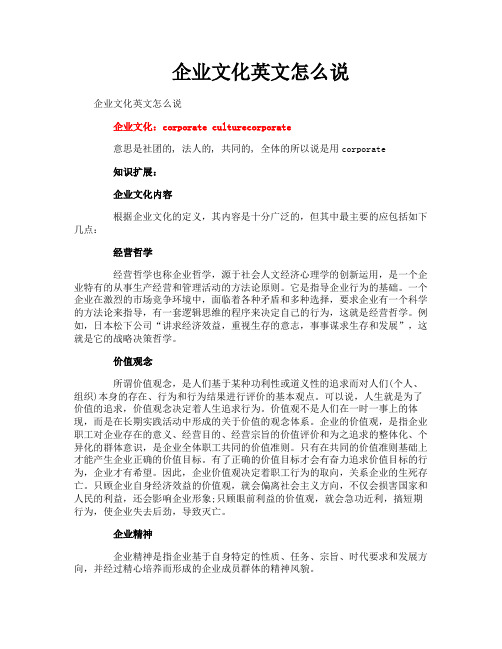
企业文化英文怎么说企业文化英文怎么说企业文化:corporate culturecorporate意思是社团的, 法人的, 共同的, 全体的所以说是用corporate知识扩展:企业文化内容根据企业文化的定义,其内容是十分广泛的,但其中最主要的应包括如下几点:经营哲学经营哲学也称企业哲学,源于社会人文经济心理学的创新运用,是一个企业特有的从事生产经营和管理活动的方法论原则。
它是指导企业行为的基础。
一个企业在激烈的市场竞争环境中,面临着各种矛盾和多种选择,要求企业有一个科学的方法论来指导,有一套逻辑思维的程序来决定自己的行为,这就是经营哲学。
例如,日本松下公司“讲求经济效益,重视生存的意志,事事谋求生存和发展”,这就是它的战略决策哲学。
价值观念所谓价值观念,是人们基于某种功利性或道义性的追求而对人们(个人、组织)本身的存在、行为和行为结果进行评价的基本观点。
可以说,人生就是为了价值的追求,价值观念决定着人生追求行为。
价值观不是人们在一时一事上的体现,而是在长期实践活动中形成的关于价值的观念体系。
企业的价值观,是指企业职工对企业存在的意义、经营目的、经营宗旨的价值评价和为之追求的整体化、个异化的群体意识,是企业全体职工共同的价值准则。
只有在共同的价值准则基础上才能产生企业正确的价值目标。
有了正确的价值目标才会有奋力追求价值目标的行为,企业才有希望。
因此,企业价值观决定着职工行为的取向,关系企业的生死存亡。
只顾企业自身经济效益的价值观,就会偏离社会主义方向,不仅会损害国家和人民的利益,还会影响企业形象;只顾眼前利益的价值观,就会急功近利,搞短期行为,使企业失去后劲,导致灭亡。
企业精神企业精神是指企业基于自身特定的性质、任务、宗旨、时代要求和发展方向,并经过精心培养而形成的企业成员群体的精神风貌。
企业精神要通过企业全体职工有意识的实践活动体现出来。
因此,它又是企业职工观念意识和进取心理的外化。
企业精神是企业文化的核心,在整个企业文化中起着支配的地位。
企业文化用英语怎么说
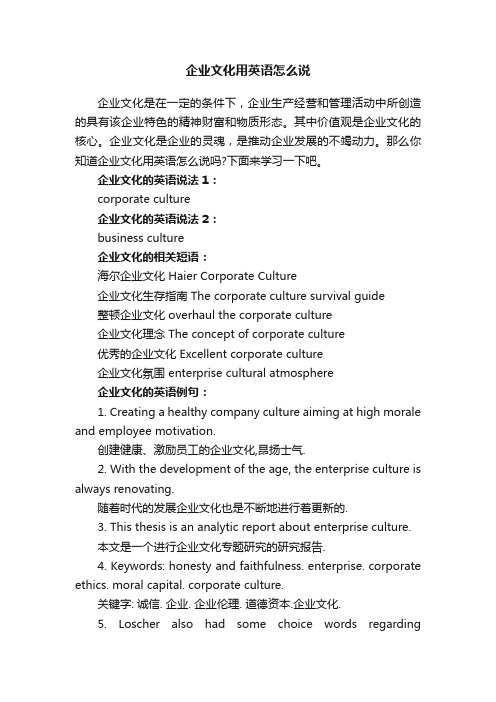
企业文化用英语怎么说企业文化是在一定的条件下,企业生产经营和管理活动中所创造的具有该企业特色的精神财富和物质形态。
其中价值观是企业文化的核心。
企业文化是企业的灵魂,是推动企业发展的不竭动力。
那么你知道企业文化用英语怎么说吗?下面来学习一下吧。
企业文化的英语说法1:corporate culture企业文化的英语说法2:business culture企业文化的相关短语:海尔企业文化 Haier Corporate Culture企业文化生存指南 The corporate culture survival guide整顿企业文化 overhaul the corporate culture企业文化理念 The concept of corporate culture优秀的企业文化 Excellent corporate culture企业文化氛围 enterprise cultural atmosphere企业文化的英语例句:1. Creating a healthy company culture aiming at high morale and employee motivation.创建健康、激励员工的企业文化,昂扬士气.2. With the development of the age, the enterprise culture is always renovating.随着时代的发展企业文化也是不断地进行着更新的.3. This thesis is an analytic report about enterprise culture.本文是一个进行企业文化专题研究的研究报告.4. Keywords: honesty and faithfulness. enterprise. corporate ethics. moral capital. corporate culture.关键字: 诚信. 企业. 企业伦理. 道德资本.企业文化.5. Loscher also had some choice words regardingSiemens'corporate culture.Losche还有一些关于西门子企业文化的措词.6. Include spirit is the principal premise that compose builds group company culture.包容精神是构建集团企业文化的首要前提.7. How to construct a wholesome corporate culture for family enterprise?如何建设一个健康的家族企业文化?8. At the same time, concentrate efforts on the cultural advancement building enterprise.同时, 致力于建设企业文化建设.9. Have an open mind and to embrace the corporate culture.拥有一颗开放的心,学会接受不同的企业文化.10. Company culture builds the underlying demand that is modern business management.企业文化建设是现代企业治理的内在要求.11. This article has conducted systematical research to Chinese chuangye corporate culture construction.本文对中国创业企业文化建设进行了系统研究.12. That's why Enterprise Culture and rules are always mentioned.因此企业文化,员工守则等经常被提起.13. In a strict sense, corporate culture cannot be confused with organization culture.严格的说, 企业文化和组织文化不应该混为一谈.14. Chinese family enterprises can select three breakthroughs in building excellent enterprise culture.在中国建立优秀的家族制企业文化,可以选择三个突破口.15. We need to revive a culture of stability and responsibility in business.我们需要重振求稳和负责的企业文化.。
企业文化建设(英文)

ReportIntroductionIn any companies has its own culture. Some culture is strong, others culture is weak. No matter the culture is strong or weak that will impact on the development of enterprises. Therefore, enterprises should also take effective measures to maintain the corporate culture.Wegman is a grocery store. He has a strong corporate culture, but also affect their employees follow the Wegman's culture.1. Strong and Weak Culture1.1 Definition of Strong and Weak cultureAn organization must be composed of both a variety of cultural. So we can divide these into strong and weak culture, according to different attributes of cultures. Strong Culture is the key values are strongly held and widely recognized cultural organizations by the public. Strong Culture will restrict a manager's decision-making related to choice of all management functions.It determines what people should do or not do anything. Organizations have strong cultures have a very clear recognition of the value. Strong cultural impact for the employee's behavior, and reduce staff turnover have more direct contact. On the contrary, (Philip Kotler & Gary Armstrong , [M] 2021 ) Weak Culture is the key values that cannot be widely accepted and strongly insist cultural organizations.In a strong culture, the organization's core values are both strongly held and widely shared.The more members who accept the core value and the greater their commitment to those value is, the stronger culture is. Consistent with this definition, a strong culture will have a great influence on the behavior of its employees because the high degree of sharing and intensity creates atmosphere of high behavior control.1.2 The culture of WegmanCharacterize Wegman's culture is a Strong Culture. Strong culture for the greater impact of employee behavior, and reduce staff turnover have a more direct relationship.A special resultof a strong culture should be lower employee turnover. (Robbins, S.P. and Coulter, [M], 2007) A strong culture demonstrates high agreement among members about what the organization standers for. Such unanimity of purpose builds cohesiveness, loyalty and organization commitment. These qualities, in turn, lessen employees’ propensity to leave the organization.In general, grocery stores are not considered as a good place to work. Compared with other professions, Low income is in this profession. The result is an industry that sees high annual turnover rate. Employees at Wegman, however, view working for a grocer a bit differently. Instead of viewing their job as a temporary setback on the way to a more illustrious career, many employees at Wegman view working for the company as their career. This is because there is a strong culture of Wegman; it can cultivate working interest of employees so that employees take pride at work. Employees and the company formed a consistent identity.1.3 How Wegman’s cultural to influence staffWegman want to let the culture which is dynamic, happy, mutual aid, loyalty can affect every employee, and will sustain this culture. Therefore, the Wegman has done a lot●Ingrained managersWegman's culture is ingrained in the senior managers. More than half of these managers start working here since a teenager. Wegman's cultural impact on them is profound. They have been working at Wegman at least two decades; their feelings of Wegman are deep.Their understanding of the company's culture is also very thorough. Thus, these managers leadership employees, they will follow the Wegman's culture, which can cultivate a loyal Wegman's employees. This enables the formation of cultural heritage●Careful selection employeesWegman’s is very carefully in selecting employees. Employees at Wegman are not selected based on the mental ability or experience, but in the interest of the candidates asa judgment standard. Wegman wish to hire employees a real interest in food, they canhelp the company maintain concerned on the delicious food.Such employees are in line with Wegman's own culture, they are also more likely to accept the company's other cultures.●Cautious expansionBecause Wegman’s carefully selects employees. So the growth is often slow and meticulous, with only two new stores opened each year. While this rate of expansion is slow but it can ensure that each store contains a strong culture of WegmanWhen a new store is opened, employees from existing stores are brought into the new store to maintain the culture. The exiting employees are then able to transmit their knowledge and the store’s values to the new employees.2. Wegman's Culture2.1 The primary source of Wegman's cultureThe organization's current customs, tradition, and the general way of doing things are largely due to what it in has done before and degree of success it has had with those endeavors. This leads us to the ultimate source of an organization’s culture: its founder.Founders of the organization traditionally have a major impact on the early culture. They have a vision of what the organization should be doing something for future. They do not accept the previous practice or the shackles of ideology. (Li Sufang [J] 2021) A typical feature of the new organization is small size.This is further beneficial that the founder impositions of their own vision on all members. There are three ways to create a cultural.●First: founders hire and keep only employee who think and feel the same way they do.●Second indoctrination and socialize employees to their way of thinking and feeling.●Finally founders’ own behavior acts as a role model that encourage employees to identifywith them and thereby internalize their beliefs, values, and assumption.Wegman's flagship store located in New York, which is the brothers of John and Walter Wegman founded in 1930. Its special feature is a coffee shop that seated in the store can accommodate 300 people. Obviously, founders pay attention to the delicious foods highly.Therefore, they hire people who are really interested in food. This helps to maintain the founders’ideas focusing on the food, creating the original Wegman's culture. Wegman's development it seems to be successful today. Thus, the founders’ attention to the delicious food becomes seen as a primary determinant of that success. His successor is constantlystrengthened and developed new cultures, such as increased employee benefits. At this point, the founders’ entire personality becomes embedded in the culture of the Wegman.2.2 Sustain own cultureOnce a culture is in place, there are practices within the organization that act to maintain it by giving employees a set of similar experiences. The selection process, performance evaluation critical, training and development activities, and promotion ensure that those hired fit in with the culture, reward those who support it. (Stephen P. Robbins & Timothy A. Judge [M] 2021) In sustain Wegman’s cultural process, mainly used two methods:Selection practices, the actions of top management.●Selection practicesThe explicit goal of the selection process is identify and hire individuals who have theknowledge, skills, and abilities to perform the job within the job within the organizationsuccessfully. Wegman is a food store, he hired staff, of course, is interested in food as acondition of selection. This selection criteria and Wegman's culture to maintain have asignificant relationship. In this way, the company in the selection staff process insisted theWegman culture, screening out those who are not interested in food, or threatenWegman's culture.●The actions of top managementThe actions of the top management also have a major impact on the organization’s culture.Top management, through what they say and behavior to establish the role model,penetrating into the organization used to maintain the organization's culture.Wegman'sfirst generation of managers to focus on employee interest in food, so whether intentionalor not employees will pay attention to food’s concerns.Walter's son Robert served asPresident, he believed himself and the employee has not different,Walter's son aspresident, he and the staff do not consider themselves different, so he immediatelyincrease the number of employees generous benefits, such as profit sharing and medicalcoverage completely paid for by the company. Now the Wegman president is Robert's sonDanny. He continued to carry forward the Wegman's traditional of concerning for itsemployees2.3 Another ways to maintain company's culture——SocializationIn addition to selection practices and acting of top management, maintained organization culture approach there are many types. Socialization is an effective method. No matter how good organization does in staff selection and recruitment,new employees cannot fully adapt to the organizational culture.Because they are not familiar with the organization's culture.(Stephen P. Robbins & Timothy Judge [M] 2021) New employees are likely to disturb the concepts and habits that are in placed in organization. Organizations will, therefore, need to help new employees adapt to the organization's culture.The adaptation process is called socializationSocialization can be divided into three stages. Prearrival Stage: Including all learning activities occurred before the new members to participate in Organization. During this phase, we can clearly see each individual's different values and expectations of the company.Encounter Stage: At this stage, new members can see the true character of the organization.New employees may face to disconnected problem between personal expectations and reality.The period is a crucial stage of the process socialization. It is when the organization seeks to mold the outsiders into an employee “in good standing〞Metamorphosis Stage: To solve the problem during the collision may last a relatively long period of time. The new employee masters the skills required for the job that successfully performs the new roles, and makes the adjustments to the work group’s values and norms.For example, at Limited Brands, Newly appointed vice president and regional director through One month training program, it called “onboarding〞. Purpose is to allow these senior executives integrate into the company's culture. During the month they have to no direct responsibilities for tasks associated with their new positions. Instead, they spend all their work time meeting with other senior leader and mentors working the floors of retail stores, evaluating employee and customer habits, investigating the competition, and studying Limited Brands’past and current operations.3. Learn Culture in Wegman3.1 How to learn Wegman's cultures——StoriesEach company will circulated a number of small stories in companies. They are usually the following aspects: founder experience, cutting workers, increase labor welfare. The purpose of promoted the story is to provide explanation and support for the organization's policy. In Wegman, managers often tell employees to Wegman's founders set up in the store coffee shop, that unique approach to food concern make Wegman stands out in many grocery stores.Wegman use a part-time in the company's 19-year-old college students Sara as an example. He always remembers John Wegman for her help to display shop full of praise. “I love this place〞she says. “If teaching does not work, I would do a full-time at Wegman〞Wegman’s with specific story shows that working in the Wegman is a matter of pride for the employees. This method is an important reason for the success of Wegman's culture. Reflects, among employees and Wegman, have a strong cohesion. Frequently described such stories, it provide a good explanation and channel to understand the Wegman's culture for Wegman's employees, especially new employees.3.2 Another ways t to learn company’s cultureExcept telling stories, Wegman also can transfer their corporate culture to subordinates in many ways. Other effective methods like establishment of a fixed ritual, Creation of material symbol, and using the internal language.●Establishment of a fixed ritualRituals are repetitive sequences of activities that express and reinforce the key values ofthe organization—what goals are most important, which people are important, and whichpeople are expendable. Wegman can create their service standards into the slogan,requiring employees to read out loud every morning, as an incentive way to the employeesto follow corporate culture. Morning, we began to work, reading the slogan can increaseemployees' motivation. for work, can also remind staff to allow employees morememorizing Wegman's culture Through this ceremony, members of the Wegman's closelylinked, and to strengthen the Wegman's culture, among the staff.●Creation of material symbolThe layout of corporate headquarters, the type of automobiles top executives are given,and the presence or absences of corporate aircraft are a few exemplas of material symbol.Wegman can set their own material symbol, such as the size of the office at different levels, various positions of office furniture grade, the additional allowances and clothing to senior manager. These materials convey to staff such a symbol of information that who is important, the degree of what equality by executives expects, and what behavior isappropriate. As Wegman's culture believes that managers and ordinary employees is not much difference, they are very concerned about the employees and many generousbenefits to employees.So the material symbol may not be obvious in Wegman.Using the internal languageOrganizations, over time, tend to develop some specific terms, the internal language, to describe with equipment, office, key personnel, suppliers, customers, which related to their business. Wegman and departments within the Wegman should create some internal language, and use these languages as a way to identify members of Wegman culture or subculture. In general, Wegman's employees just entered would be confused by thesephrases and jargon, but about six months later, these elements will be turned into part oftheir language. Once employees who mastered this internal language, it formed employees of the common features with Wegman’s culture.This also conducive to theprotection Wegman’s culture3.3 The most effective way to learnI think the most effective method is to structures and provide a learning platform foremployees. Learning platform refers to that everyone participated equal, interactive communication, and exchange and sharing of learning spaces, learning opportunities and learning tools.The main forms are: network learning, books databases, training, conferences, and study room.The company has a bright and spacious library staff can support all kinds of learning materials and a good learning place; maturing of the internal and external training would provide employees with the opportunity to update professional knowledge; modern networked office conditions can offer employees with more learning opportunities.This able to create a learning environment that can advocate the idea of at work to learn, the learning to work, tocreate a good learning environment and opportunities for the staff. So that learning will becomea culture.4. The Importance of CultureIn order to develop, enterprises must seek more scientific, more systematic and complete management system. Culture provides the necessary organizational structure and management mechanisms. Contemporary companies to maintain steady and continuous development must be develop its own unique corporate culture. Building of enterprise culture has an important role for enterprise development strategies, improve enterprise management.4.1 Promote to improve the core competitivenessCorporate cultures promote to improve the core competitiveness of enterprises. In the widely shared values under the guidance of business practices, employees will have a sense of belonging, mission, and identify with corporate image. (Guo Songyang [J] 2006) Corporate culture is the internal dynamics of enterprise development. This is mainly embodied in the three functions●Cohesion function. It can put people together tightly; make their purpose clear andcoherent.As long as the fundamental goal choosing the right company, we can make the corporate profits of most of the workers unify and form a strong cohesiveness.●Oriented functions. Corporate values and entrepreneurial spirit can put forwardlong-term significance for the company development strategy. Corporate culture is the fundamental basis for the development of competitive strategies and policies in the market competition.●Motivate function. Motivation is a kind of spiritual power and status, which mobilize andstimulate enthusiasm, initiative and creativity of workers.It allows employees to find the goal, and the opportunity to play talent.4.2 To the Besunyoung’s culture as an exampleBesunyoung in the corporate culture, "integrity, pragmatic, innovative" business philosophy is highly respected. Based on this, Besunyoung create a good team, both in market research andplanning or product promotion. Besunyoung have been in this business philosophy, as the cornerstone of development. And created a lot of "Besunyoung" miracle in the domestic field of health tea.〔Zhou Yunhe & Luo Wen [J] 2021) Besunyoung raised the requirements of a sense of ownership. It is that to each individual regard company as their own home, to promote the work actively. This concept, not only serve as a cohesiveness, to unite its members, but also play a role in adaptation, for the employees to create a good environment and atmosphere.Attention to personnel training can be said that is the most critical aspect of Besunyoung culture. Besunyoung structures an open platform for their employees’ growth, building a unique culture of Besunyoung. Practice shows that Besunyoung cultural infiltration in the organizational structure, employee behavior, the site is the soul of Besunyoung and lasting power, is also fundamental development.ConclusionSuccessful companies have in common is that they have a unique culture and give full play orientation, cohesion, incentive, such as the dominant company ideology, values, beliefs and so on. Through the corporate culture allows us can find ways to establish and cultivate the character y, innovation, service awareness company desired, to promote enterprise’s development with healthy and harmonious.References●Guo Songyang [J] 2006. Enterprise Culture How to Realize Effective PerformanceManagement. Economic and Social Development pp.45—46●Li Sufang [J] 2021 Brand Concept and Corporate Culture Is a Manifestation of Soft PowerCorporation Research—79●Philip Kotler & Gary Armstrong , [M] 2021 Principles of Marketing(Twelfth Edition)●Robbins, S.P. and Coulter, [M], 2007. Management. 8th Ed. Beijing: Tsinghua University Press ●Stephen P. Robbins & Timothy A. Judge [M] 2021 “Organizational behavio r〞Tsinghuauniversity press,●Zhou Yunhe & Luo Wen [J] 2021 Besunyoung Culture On The Importance Of EnterpriseDevelopment Enterprise and Culture pp 36—39●Hu Yong,[J] 2021 Talking About The Construction of Family Business Culture ApproachBusiness Weekly●Liu Songqi; Yi Qungan [J] 2007 Corporate Culture And Job Satisfaction: The Regulatory RoleOf Personality Peking University (Natural Science)●Cai Xiang; Zhang Guangping; Trisha; [J];2007 Corporate Culture Of Loyalty Of KnowledgeWorkers Influence A Number Of Propositions; Industrial Technology and Economy;●Sun Aiying,[J] ,2006. A Study on the Relationship Between the Discrepancy of CorporateCulture and Portfolio Innovation, Science Research Management., pp15-18.●。
企业文化建设外文翻译文献
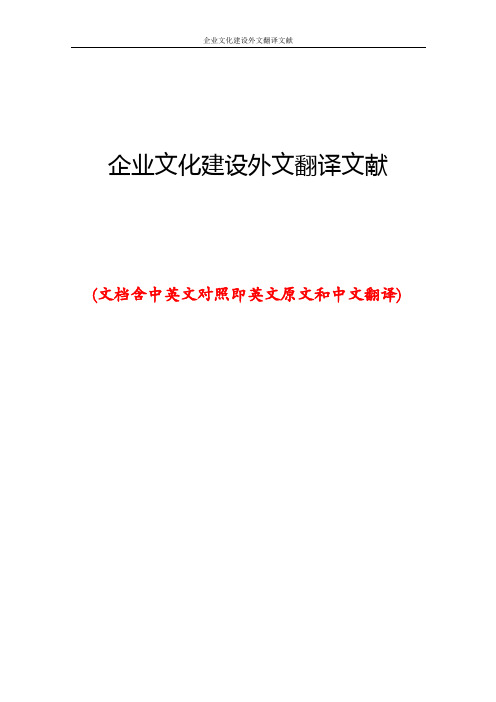
企业文化建设外文翻译文献(文档含中英文对照即英文原文和中文翻译)原文:Enterprise culture:necessary in promoting enterpriseSteven CarterThe paper investigates the effects of the Zimbabwean national culture on enterprise development. In-depth interviews were carried out with fifteen entrepreneurs and seven members of the community whose role was to support entrepreneurs. It was established that the national culture impeded enterprise development and the factors identified are: bad debt culture, let's-pull-him-downsyndrome, dependency syndrome, high living, and absence of role models, refusal to accept entrepreneurship, employing relatives and poor quality goods and services. To promote enterprise development, countries need to identify factors that make up the national culture. The paper also identifies the desired enterprise culture.INTRODUCTIONEarlier research on enterprise development mainly focused on the personal characteristics/traits of the individual, such as the need for achievement, locus of control, the ability to take risk, etc (McClelland, 1962; McClelland and Winter, 1969; Bellu, 1988; Rotter, 1966). Curran (1994) argued that traits alone were inadequate to explain entrepreneurship, and some found no direct link between traits and entrepreneurial behaviour (Bird, 1988; Guth, 2001). Hence, further research moved on to considering the environmental factors (political, cultural, economic, regulations and policies) that affect enterprise development. It was argued that countries desiring to promote enterprise development need to address these environmental factors (Telantino, 1995; UNCTAD, 1995; Gnyawaii, 1994; Bird, 1989; Chell, 1985; Vaselainen, 1999).Enterprise development has been viewed as a means of reducing unemployment, easing other social problems and as the best way of creating wealth in a country (Nolan, 2003; Storey, 2000). As a result of the above reasons, both developing and developed countries have embraced enterprise development.Like many other countries, Zimbabwe has run enterprise development programmes, created and adopted policies aimed at creating a conducive environment for enterprise development. Unfortunately, the efforts to promote enterprise development in Zimbabwe have not been successful(Mlambo, 2000; UNDP, 2000).The paper explores the factors that make up the Zimbabwean national culture relating to enterprise development. It also establishes the effects that these factors have had on enterprise development.LITERATURE REVIEWCulture is defined as a set of historically evolved, learned values, attitudes and meanings shared by the members of a given community, that inlluence their material and non-material way of life (Tayeb, 1988). These evolve through different stages of socialisation, through institutions like family, religion, formal education etc. It was further asserted that different cultures influence enterprise development differently (Hofstede, 1991). Furthermore, others believe that the national culture should be included when discussing enterprise development of the country (Wortzel, 1997; Morrison,2000). For example, it was believed that enterprise development success in USA was as a result of its culture that promotes individualism (De Pillis eta/, 1998; Wong, 2001), while failure of enterprise development in Ireland was as a result ofa culture that promotes conformity to the status quo (DePillis, 1998). In India, enterprise development encountered problems due to a culture that promoted spiritual harmony and acceptance of destiny (Dana, 2000). Similarly, entrepreneurship has not succeeded in countries where it has a bad image, where entrepreneurs are viewed as greedy, unkind, thieves, exploiters of people etc (Joyant and Warner, 1996; Morrison, 2000; Bateman, 1997). On the other hand, entenrise development succeeds in a nation that embraces it, where it is viewed as a noble way of life and especially where failure is not demonised by the society (Morrison, 2000; Wong 2001; De Pillis, 1998; Nolan, 2003). Enterprise success has also been recorded in countries where there are role models who would inspire others (De Pillis, 1998). Role models can even be members of one's immediate or extended family (Gibb, 1996). Therefore, countries can attempt to promote enterprise development by accepting and elevating the societal rolemodels and raising the practical support given to entrepreneurs (Raynolds, 1991; Specht, 1993).Entrepreneurs who enjoy 'high-living' at the expense of their enterprises have difficulties in succeeding (Spring, 1998). In both developed and developing countries, some graduates dislike being associated with working for Small to Medium Enterprises (SMEs) and self-employment. This makes it difficult for some countries to promote enterprise as it is not accepted by the very people who have the best capacity to succeed as business people and Morrison (2000) argues that formal education system is to be blamed for producing conformists and not entrepreneurs. To address this, Stevenson (1996) argues that entrepreneurship should be taught from a young age, in schools and colleges.Meyanathan (1994) demonstrated the difficulties in promoting enterprise in a country that favours a certain group of people over others; because the ones favoured will develop a sense of entitlement, whilst the neglected resent the entire system.Literature researched has discussed different aspects of culture that have affected enterprise development, but there has not been a comprehensive catalogue of these factors that make up a national culture relating to enterprise development. Hence, this paper explores the factors that make up the national culture, and, in particular, those relating to enterprise development in Zimbabwe.RESEARCH METHODThe paper seeks to explore and explain the cultural factors that have negatively affected enterprise development in Zimbabwe. There is need to answer the questions, what are the national cultural factors that have affected enterprise development in Zimbabwe, how have they affected it and why? Hence, an interpretive approach was adopted (Carson, 2001). Within interpretivism, a qualitative research approach was used. This approach allows the inclusion of tacit knowledge and experience of the researcher throughout the research process. Based on the qualitative research method,non-probabilistic (purposeful) sampling was carried out, where the respondents pointed the researcher to the next respondent (Remenyi, 2001).This is called snowballing.The sample was made up of twenty-two respondents (elites). All respondents were 'elites' chosen for their expert knowledge (Remenyi,1998; Lincoln and Guba, 1990) of enterprise development in Zimbabwe.Among them were fifteen entrepreneurs and seven respondents whose occupations or activities supported entrepreneurs. The purpose for sampling the other seven'elites' was triangulation (Remenyi, 1998;Lincoln and Guba 1990; Carson 2001). There was needed to get a different view from that of entrepreneurs, that is, those who supported the work of entrepreneurs (from financial organisations, development and training organisations and the government). These respondents had supported entrepreneurs through financing, training etc. for at least six years. All entrepreneurs interviewed were business people who had started and managed their enterprises for more than six years.Consistent with this research approach, face-to-face in-depth interviews were carried out using an interview guide. The interview guide was based on the themes that had been obtained from literature and needed further exploration. Respondents were asked to identify and discuss all factors they believed had negatively affected enterprise development in Zimbabwe.The collected data was analysed using the thematic analysis, as described by Miles and Huberman (1994), and Wengraf (2001). The research was conducted in two phases. The initial phase culminated in establishing a list of cultural factors that have affected enterprise development. After the first round ofinterviews with the 22 respondents, their responses were analysed. The results were then subjected to further scrutiny by nine respondents who had taken part in the first round of interviews, and who were hence familiar with this research and considered able to provide the sound scrutiny. Furthermore, a programme that was established to promote enterprise development was also evaluated as a way of triangulation. It was a way to find if there was any convergence on the cultural factors mentioned by the entrepreneurs as having negatively affected enterprise development and those that had affected the programme. Therefore, the second round ofinterviews and an evaluation of the enterprise developing programme were to provide further verification, a way of improvingtrustworthiness and rigour.The research methodology adopted allows the researcher to use tacit knowledge and experience throughout the process; hence there will be instances (in presenting the findings) where some assertions are not sourced,but are attributed to the researchers' knowledge and experience of Zimbabwe.Consistent with the research method, in presenting findings of this research, a summary of the respondents' views is provided and to emphasise this position some quotations are included in the text and a sample of others can be found in.One respondent said: remember, our culture does not necessarily promote people who succeed. Success is not very much part of our culture.From the respondents' point of view, one of the reasons why enterprise development did not flourish in Zimbabwe was its national culture.The factors that make up the Zimbabwean national culture and have negatively affected enterprise development are: bad-debt culture, absence of role models, let's pull-him-down syndrome, dependency syndrome, poor quality goods and service delivery, refusing to accept entrepreneurship as a way of life, employing relatives (kith and kin) and high living.The above factors will now be elaboratedBad-debt CultureOne entrepreneur said: people do not payback because there is bad debt culture; it is bad debt culture, which we need to jight. United Merchant Bank (UMB) went under, it went down because people were not paying back, though the owner had wanted to help fellow indigenous people.Although some respondents held this view, it should be noted that non-payment was not the only reason why UMB went into liquidation.UMB was established at the height ofindigenisation and by an indigenous entrepreneur. UMB considered itself a champion ofindigenisation and accused the traditional multinational banks of failing to support indigenous entrepreneurs. On a weekly basis, this bank advertised in the national press, the need to indigenise and made the accusations mentioned above.According to UMB, the traditional banks' lending conditions were too strict and their demands could not be easily met by most indigenous entrepreneurs; for example,collateral and own contribution. Consequently,UMB urged them to follow its example of relaxing the borrowing requirements, where collateral was less emphasised than other aspects likeproject viability and management. As a result, good project proposals (on paper) were produced, received funding; unfortunately, money was not paid back and without collateral the bank could not recover its debts and it went into liquidation. As a result, depositors' funds were lost. In short,UMB did not follow prudent lending practice; hence, it is as much to blame as the borrowers who failed to pay back. UMB failed to take into cognisance the bad-debt cultural dimension among its borrowers.Enterprise Culture: Necessary In Promoting EnterpriseThere has been ample evidence to support this assertion. The research established that in 1992, the government made available Z$100 million to support indigenous businesses and the default rate for this money was about twenty eight percent (28%). In 1994, the government provided $400 million for indigenous enterprises and the default rate for this facility was about thirty two percent (32%). In 1997, the World Bank and the government made another 2$700 million available and the default rate was about thirty one percent (31%). In 2000, the government availed 2$4 billion as a revolving fund for enterprise development and by 2002 0nly $2billion could be revolved, the rest was lost to bad debtors. There are other examples, where certain individuals have borrowed from banks and not paid back. For example, Mr. Sibanda (not his real name) who is now a well known property mogul in Zimbabwe; has borrowed huge amounts from different banks to buy several companies (one company was a shoe making company, another manufacturing conglomerate, bought shares in a cement making company and others) and has been a bad debtor. Through his property developing company, he developed properties using borrowed money from a building society and did not pay back. The building society later on went into financial difficulties (not necessarily because of him alone) and had to be rescued by the Central Bank.The aspect of bad debt culture relates to the fact that entrepreneurs likeborrowing, but not paying back what they borrow. It was established that those who lend to the entrepreneurs face major challenges in collecting their debts from the borrowers. Respondents believed that many entrepreneurs are under the impression that one can borrow but not necessarily need to pay back. As a result of this culture and resultant behaviour, some programmes (including donor money mentioned above) that lent money to SMEs have had high default rates.Date Source: Steven Carter.Enterprise culture:necessary in promoting enterprise;less- ons from enterprise development in Zimbabwe[J]. Journal of Enterpring Culture,2006 (3):P177-198译文:企业文化:促进企业的必备要素史蒂文·卡特本论文研究的是津巴布韦国家文化对企业发展方面的影响。
n开头的企业文化单词

n开头的企业文化单词
在企业文化建设中,一些以“n”开头的英文单词可以用来表述关键的企业价值观或理念:
1. Nurture - 培养、培育
释义:强调企业对员工成长和发展的重视,致力于提供一个利于个人与团队共同进步的工作环境。
2. Navigate - 领航、导航
释义:象征着企业在市场中的领导力和战略方向感,表达公司能够引领行业趋势,为未来制定清晰的发展路径。
3. Network - 网络、联系
释义:体现企业内部协作和外部合作的重要性,提倡开放沟通、共享资源和建立强大的业务伙伴关系。
4. Novelty - 新颖性、创新
释义:鼓励企业持续创新,追求新的思路和技术,不断推出具有创新价值的产品和服务。
5. Nimble - 敏捷、灵活
释义:倡导企业快速适应市场变化,保持组织灵活性和高效执行力。
6. No-nonsense - 实事求是、不讲空话
释义:表明企业注重实际效果,推崇务实作风,不崇尚形式主义。
7. Noble - 高尚的、尊贵的
释义:强调企业的道德品质和社会责任感,追求崇高的商业道德和公益行为。
8. Nurturing Innovation - 倡导创新文化
释义:指明企业积极营造一种鼓励和支持创新的文化氛围。
9. Never Compromise on Quality - 坚持质量第一
释义:明确企业在产品或服务质量上的坚守原则,绝不妥协。
企业文化建设英文版

企业文化建设英文版1. IntroductionCorporate culture is a crucial aspect that defines the identity and success of an organization. It encapsulates the values, beliefs, and practices of an enterprise thatultimately shape its behavior, performance, and reputation. A strong corporate culture contributes to employee engagement, satisfaction, and retention while fostering a positiveworking environment. This article will explore the importance of corporate culture, key elements, and strategies to build and sustain it for long-term growth and success.2. Importance of Corporate CultureThe significance of corporate culture lies in its ability to differentiate an enterprise from its competitors. It isthe unique set of values and beliefs that driveorganizational behavior, decision-making, and actions. A positive corporate culture can enhance employee collaboration, loyalty, and productivity while promoting a positiveperception among customers, stakeholders, and investors.Moreover, corporate culture plays a pivotal role in attracting and retaining quality talent. A company with apositive work environment and supportive culture is likely to attract top performers who prefer an organization that aligns with their values and goals. Additionally, a robust corporate culture resonates with customers and enhances brand reputation, inviting more business opportunities and growth.3. Key Elements of Corporate CultureEffective corporate culture is built on a foundation of key elements that embody the values, vision, and mission of an organization. These elements include:3.1. LeadershipLeadership is critical to establishing the tone and direction of corporate culture. Leaders should lead by example, communicate vision, and reinforce values through their actions and behavior.3.2. ValuesCorporate culture is built on a set of shared values that reflect the core beliefs and principles of an organization. These values drive behavior, actions, and decisions and are essential in creating a positive work environment.3.3. CommunicationEffective communication is crucial to maintain transparency, clarity, and teamwork within an organization.It fosters a collaborative atmosphere and promotes a sense of ownership and involvement among employees.3.4. Recognition and RewardsRecognizing and rewarding employees for their accomplishments and contributions reinforces positive behavior and motivates them to perform at their best.4. Strategies for Building Corporate CultureBuilding a positive corporate culture requires astrategic approach that involves the active participation and support of employees at all levels of the organization.4.1. Define Company ValuesThe first step in building an effective corporate culture is to define company values that align with the mission and vision of the organization. The values should be communicated clearly and consistently to every employee.4.2. Hire for Cultural FitHiring employees that fit the values and culture of the organization is essential. Cultural fit enhances employee engagement, performance, and longevity in the organization.4.3. Encourage CollaborationEncouraging collaboration among employees fosters teamwork, enhances creativity, and promotes a supportive working environment. It also helps to build social bonds that strengthen relationships among employees.4.4. Support a Work-Life BalanceSupporting a work-life balance improves employee satisfaction, reduces stress, and promotes overall well-being. It also enhances employee loyalty and retention.5. ConclusionCorporate culture is a critical determinant of an organization's success, and it requires active participation and support from all levels of the organization. A positive corporate culture enhances employee engagement, loyalty, and productivity while promoting a positive brand image. Building a strong culture requires defining shared values, encouraging collaboration, supporting a work-life balance, and rewarding employees for their contributions. With a committed effortfrom the leadership team and employees, a positive corporate culture can lead to sustainable growth and long-term success.。
企业文化墙英文版
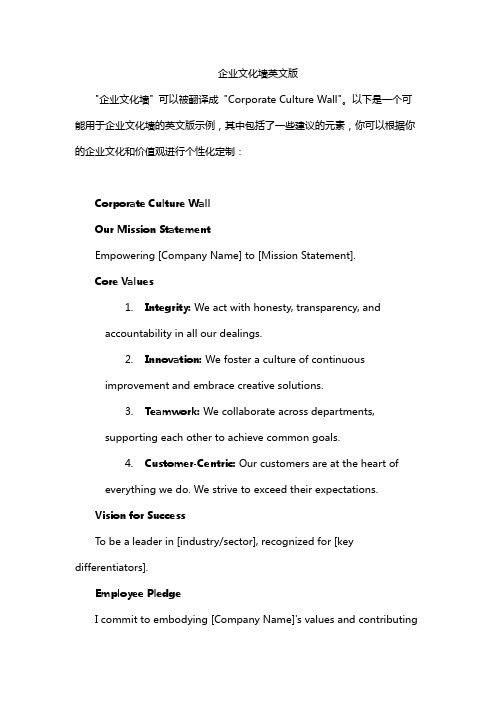
企业文化墙英文版"企业文化墙" 可以被翻译成"Corporate Culture Wall"。
以下是一个可能用于企业文化墙的英文版示例,其中包括了一些建议的元素,你可以根据你的企业文化和价值观进行个性化定制:Corporate Culture WallOur Mission StatementEmpowering [Company Name] to [Mission Statement].Core Values1.Integrity: We act with honesty, transparency, andaccountability in all our dealings.2.Innovation: We foster a culture of continuousimprovement and embrace creative solutions.3.Teamwork: We collaborate across departments,supporting each other to achieve common goals.4.Customer-Centric: Our customers are at the heart ofeverything we do. We strive to exceed their expectations.Vision for SuccessTo be a leader in [industry/sector], recognized for [key differentiators].Employee PledgeI commit to embodying [Company Name]'s values and contributingto a positive and inclusive workplace.Employee RecognitionCelebrating the outstanding contributions of our team members.Social ResponsibilityEngaging in meaningful initiatives to give back to our communities.Diversity and InclusionValuing and respecting the diversity of our employees, fostering an inclusive environment.Employee WellbeingPrioritizing the health, safety, and work-life balance of our team members.请注意,以上只是一个示例,实际的企业文化墙应该根据你的企业的独特性和价值观进行个性化设计。
- 1、下载文档前请自行甄别文档内容的完整性,平台不提供额外的编辑、内容补充、找答案等附加服务。
- 2、"仅部分预览"的文档,不可在线预览部分如存在完整性等问题,可反馈申请退款(可完整预览的文档不适用该条件!)。
- 3、如文档侵犯您的权益,请联系客服反馈,我们会尽快为您处理(人工客服工作时间:9:00-18:30)。
ReportIntroductionIn any panies has its own culture. Some culture is strong, others culture is weak. No matter the culture is strong or weak that will impact on the development of enterprises. Therefore, enterprises should also take effective measures to maintain the corporate culture.Wegman is a grocery store. He has a strong corporate culture, but also affect their employees follow the Wegman's culture.1. Strong and Weak Culture1.1 Definition of Strong and Weak cultureAn organization must be posed of both a variety of cultural. So we can divide these into strong and weak culture, according to different attributes of cultures. Strong Culture is the key values are strongly held and widely recognized cultural organizations by the public. Strong Culture will restrict a manager's decision-making related to choice of all management functions. It determines what people should do or not do anything. Organizations have strong cultures havea very clear recognition of the value. Strong cultural impact for the employee's behavior, andreduce staff turnover have more direct contact. On the contrary, (Philip Kotler & Gary Armstrong , [M] 20XX ) Weak Culture is the key values that cannot be widely accepted and strongly insist cultural organizations.In a strong culture, the organization's core values are both strongly held and widely shared.The more members who accept the core value and the greater their mitment to those value is, the stronger culture is. Consistent with this definition, a strong culture will have a great influence on the behavior of its employees because the high degree of sharing and intensity creates atmosphere of high behavior control.1.2 The culture of WegmanCharacterize Wegman's culture is a Strong Culture. Strong culture for the greater impact of employee behavior, and reduce staff turnover have a more direct relationship.A special resultof a strong culture should be lower employee turnover. (Robbins, S.P. and Coulter, [M], 20XX) A strong culture demonstrates high agreement among members about what the organization standers for. Such unanimity of purpose builds cohesiveness, loyalty and organization mitment.These qualities, in turn, lessen employees’ propensity to leave the organization.In general, grocery stores are not considered as a good place to work. pared with other professions, Low ine is in this profession. The result is an industry that sees high annual turnover rate. Employees at Wegman, however, view working for a grocer a bit differently.Instead of viewing their job as a temporary setback on the way to a more illustrious career, many employees at Wegman view working for the pany as their career. This is because there isa strong culture of Wegman; it can cultivate working interest of employees so that employeestake pride at work. Employees and the pany formed a consistent identity.1.3 How Wegman’s cultural to influence staffWegman want to let the culture which is dynamic, happy, mutual aid, loyalty can affect every employee, and will sustain this culture. Therefore, the Wegman has done a lot●Ingrained managersWegman's culture is ingrained in the senior managers. More than half of these managers start working here since a teenager. Wegman's cultural impact on them is profound. They have been working at Wegman at least two decades; their feelings of Wegman are deep.Their understanding of the pany's culture is also very thorough. Thus, these managers leadership employees, they will follow the Wegman's culture, which can cultivate a loyal Wegman's employees. This enables the formation of cultural heritage●Careful selection employeesWegman’s is very carefully in selecting employees. Employees at Wegman are not selected based on the mental ability or experience, but in the interest of the candidates asa judgment standard. Wegman wish to hire employees a real interest in food, they canhelp the pany maintain concerned on the delicious food.Such employees are in line with Wegman's own culture, they are also more likely to accept the pany's other cultures.●Cautious expansionBecause Wegman’s carefully selects employees. So the growth is often slow andmeticulous, with only two new stores opened each year. While this rate of expansion is slow but it can ensure that each store contains a strong culture of WegmanWhen a new store is opened, employees from existing stores are brought into the new store to maintain the culture. The exiting employees are then able to transmit their knowledge and the store’s values to the new employees.2. Wegman's Culture2.1 The primary source of Wegman's cultureThe organization's current customs, tradition, and the general way of doing things are largely due to what it in has done before and degree of success it has had with those endeavors. This leads us to the ultimate source of an organization’s culture: its founder.Founders of the organization traditionally have a major impact on the early culture. They have a vision of what the organization should be doing something for future. They do not accept the previous practice or the shackles of ideology. (Li Sufang [J] 20XX) A typical feature of the new organization is small size.This is further beneficial that the founder impositions of their own vision on all members. There are three ways to create a cultural.●First: founders hire and keep only employee who think and feel the same way they do.●Second indoctrination and socialize employees to their way of thinking and feeling.●Finally founders’ own behavior acts as a role model that encourage employees to identifywith them and thereby internalize their beliefs, values, and assumption.Wegman's flagship store located in New York, which is the brothers of John and Walter Wegman founded in 1930. Its special feature is a coffee shop that seated in the store can acmodate 300 people. Obviously, founders pay attention to the delicious foods highly.Therefore, they hire people who are really interested in food. This helps to maintain the founders’ ideas focusing on the food, creating the original Wegman's culture.Wegman's development it seems to be successful today. Thus, the founders’ attention to the delicious food bees seen as a primary determinant of that success. His successor is constantly strengthened and developed new cultures, such as increased employee benefits. At this point, the founders’entire personality bees embedded in the culture of the Wegman.2.2 Sustain own cultureOnce a culture is in place, there are practices within the organization that act to maintain it by giving employees a set of similar experiences. The selection process, performance evaluation critical, training and development activities, and promotion ensure that those hired fit in with the culture, reward those who support it. (Stephen P. Robbins & Timothy A. Judge [M] 20XX) In s ustain Wegman’s cultural process, mainly used two methods:Selection practices, the actions of top management.●Selection practicesThe explicit goal of the selection process is identify and hire individuals who have theknowledge, skills, and abilities to perform the job within the job within the organizationsuccessfully. Wegman is a food store, he hired staff, of course, is interested in food as acondition of selection. This selection criteria and Wegman's culture to maintain have asignificant relationship. In this way, the pany in the selection staff process insisted theWegman culture, screening out those who are not interested in food, or threatenWegman's culture.●The actions of top managementThe actions of the top management also have a major impact on the organization’s culture.Top management, through what they say and behavior to establish the role model,penetrating into the organization used to maintain the organization's culture.Wegman'sfirst generation of managers to focus on employee interest in food, so whether intentionalor not employees will pay attention to food’s concerns.Walter's son Robert served asPresident, he believed himself and the employee has not different,Walter's son aspresident, he and the staff do not consider themselves different, so he immediatelyincrease the number of employees generous benefits, such as profit sharing and medicalcoverage pletely paid for by the pany. Now the Wegman president is Robert's son Danny.He continued to carry forward the Wegman's traditional of concerning for its employees2.3 Another ways to maintain pany's culture——SocializationIn addition to selection practices and acting of top management, maintained organizationculture approach there are many types. Socialization is an effective method. No matter how good organization does in staff selection and recruitment,new employees cannot fully adapt to the organizational culture.Because they are not familiar with the organization's culture.(Stephen P. Robbins & Timothy Judge [M] 20XX) New employees are likely to disturb the concepts and habits that are in placed in organization. Organizations will, therefore, need to help new employees adapt to the organization's culture.The adaptation process is called socializationSocialization can be divided into three stages. Prearrival Stage: Including all learning activities occurred before the new members to participate in Organization. During this phase, we can clearly see each individual's different values and expectations of the pany. Encounter Stage: At this stage, new members can see the true character of the organization. New employees may face to disconnected problem between personal expectations and reality. The period is a crucial stage of the process socialization. It is when the organization seeks to mold the outsiders into an employee “in good standing”Metamorphosis Stage: To solve the problem during the collision may last a relatively long period of time. The new employee masters the skills required for the job that successfully performs the new roles, and makes the adjustments to the work group’s values and norms.For example, at Limited Brands, Newly appointed vice president and regional director through One month training program, it called “onboarding”. Purpose is to allow these senior executives integrate into the pany's culture. During the month they have to no direct responsibilities for tasks associated with their new positions. Instead, they spend all their work time meeting with other senior leader and mentors working the floors of retail stores, evaluating employee and customer habits, investigating the petition, and studying Limited Brands’past and current operations.3. Learn Culture in Wegman3.1 How to learn Wegman's cultures——StoriesEach pany will circulated a number of small stories in panies. They are usually the followingaspects: founder experience, cutting workers, increase labor welfare. The purpose of promoted the story is to provide explanation and support for the organization's policy. In Wegman, managers often tell employees to Wegman's founders set up in the store coffee shop, that unique approach to food concern make Wegman stands out in many grocery stores.Wegman use a part-time in the pany's 19-year-old college students Sara as an example.He always remembers John Wegman for her help to display shop full of praise. “I love this place” she says. “If teaching does not work, I would do a full-time at Wegman”Wegman’s with specific story shows that working in the Wegman is a matter of pride for the employees. This method is an important reason for the success of Wegman's culture. Reflects, among employees and Wegman, have a strong cohesion. Frequently described such stories, it providea good explanation and channel to understand the Wegman's culture for Wegman's employees,especially new employees.3.2 Another ways t to learn pany’s cultureExcept telling stories, Wegman also can transfer their corporate culture to subordinates in many ways. Other effective methods like establishment of a fixed ritual, Creation of material symbol, and using the internal language.●Establishment of a fixed ritualRituals are repetitive sequences of activities that express and reinforce the key values ofthe organization—what goals are most important, which people are important, and whichpeople are expendable. Wegman can create their service standards into the slogan,requiring employees to read out loud every morning, as an incentive way to the employeesto follow corporate culture. Morning, we began to work, reading the slogan can increaseemployees' motivation. for work, can also remind staff to allow employees morememorizing Wegman's culture Through this ceremony, members of the Wegman's closelylinked, and to strengthen the Wegman's culture, among the staff.●Creation of material symbolThe layout of corporate headquarters, the type of automobiles top executives are given,and the presence or absences of corporate aircraft are a few exemplas of material symbol.Wegman can set their own material symbol, such as the size of the office at different levels,various positions of office furniture grade, the additional allowances and clothing to senior manager. These materials convey to staff such a symbol of information that who is important, the degree of what equality by executives expects, and what behavior is appropriate. As Wegman's culture believes that managers and ordinary employees is not much difference, they are very concerned about the employees and many generous benefits to employees.So the material symbol may not be obvious in Wegman.Using the internal languageOrganizations, over time, tend to develop some specific terms, the internal language, to describe with equipment, office, key personnel, suppliers, customers, which related to their business. Wegman and departments within the Wegman should create some internal language, and use these languages as a way to identify members of Wegman culture or subculture. In general, Wegman's employees just entered would be confused by these phrases and jargon, but about six months later, these elements will be turned into part of their language. Once employees who mastered this internal language, it formed employees of the mon features with Wegman’s culture.This also conducive to the protection Wegman’s culture3.3 The most effective way to learnI think the most effective method is to structures and provide a learning platform foremployees. Learning platform refers to that everyone participated equal, interactive munication, and exchange and sharing of learning spaces, learning opportunities and learning tools.The main forms are: network learning, books databases, training, conferences, and study room.The pany has a bright and spacious library staff can support all kinds of learning materials and a good learning place; maturing of the internal and external training would provide employees with the opportunity to update professional knowledge; modern networked office conditions can offer employees with more learning opportunities.This able to create a learning environment that can advocate the idea of at work to learn, the learning to work, to create a good learning environment and opportunities for the staff. So that learning will bee a culture.4. The Importance of CultureIn order to develop, enterprises must seek more scientific, more systematic and plete management system. Culture provides the necessary organizational structure and management mechanisms. Contemporary panies to maintain steady and continuous development must be develop its own unique corporate culture. Building of enterprise culture has an important role for enterprise development strategies, improve enterprise management.4.1 Promote to improve the core petitivenessCorporate cultures promote to improve the core petitiveness of enterprises. In the widely shared values under the guidance of business practices, employees will have a sense of belonging, mission, and identify with corporate image. (Guo Songyang [J] 20XX) Corporate culture is the internal dynamics of enterprise development. This is mainly embodied in the three functions●Cohesion function. It can put people together tightly; make their purpose clear andcoherent.As long as the fundamental goal choosing the right pany, we can make the corporate profits of most of the workers unify and form a strong cohesiveness.●Oriented functions. Corporate values and entrepreneurial spirit can put forwardlong-term significance for the pany development strategy. Corporate culture is the fundamental basis for the development of petitive strategies and policies in the market petition.●Motivate function. Motivation is a kind of spiritual power and status, which mobilize andstimulate enthusiasm, initiative and creativity of workers.It allows employees to find the goal, and the opportunity to play talent.4.2 To the Besunyoung’s culture as an exampleBesunyoung in the corporate culture, "integrity, pragmatic, innovative" business philosophy is highly respected. Based on this, Besunyoung create a good team, both in market research and planning or product promotion. Besunyoung have been in this business philosophy, as the cornerstone of development. And created a lot of "Besunyoung" miracle in the domestic field of health tea.(Zhou Yunhe & Luo Wen [J] 20XX) Besunyoung raised the requirements of a sense of ownership. It is that to each individual regard pany as their own home, to promote the workactively. This concept, not only serve as a cohesiveness, to unite its members, but also play a role in adaptation, for the employees to create a good environment and atmosphere. Attention to personnel training can be said that is the most critical aspect of Besunyoung culture.Besunyoung structures an open platform for their employees’ growth, building a unique culture of Besunyoung. Practice shows that Besunyoung cultural infiltration in the organizational structure, employee behavior, the site is the soul of Besunyoung and lasting power, is also fundamental development.ConclusionSuccessful panies have in mon is that they have a unique culture and give full play orientation, cohesion, incentive, such as the dominant pany ideology, values, beliefs and so on. Through the corporate culture allows us can find ways to establish and cultivate the character y, innovation, service awareness pany desired, to promote enterprise’s development with healthy and harmonious.References●Guo Songyang [J] 20XX. Enterprise Culture How to Realize Effective PerformanceManagement. Economic and Social Development pp.45—46●Li Sufang [J] 20XX Brand Concept and Corporate Culture Is a Manifestation of Soft PowerCorporation Research pp.78—79●Philip Kotler & Gary Armstrong , [M] 20XX Principles of Marketing(Twelfth Edition)●Robbins, S.P. and Coulter, [M], 20XX. Management. 8th Ed. Beijing: Tsinghua University Press ●Stephen P. Robbins & Timothy A. Judge [M] 20XX “Organizational behavio r” Tsinghuauniversity press,●Zhou Yunhe & Luo Wen [J] 20XX Besunyoung Culture On The Importance Of EnterpriseDevelopment Enterprise and Culture pp 36—39●Hu Yong,[J] 20XX Talking About The Construction of Family Business Culture ApproachBusiness Weekly●Liu Songqi; Yi Qungan [J] 20XX Corporate Culture And Job Satisfaction: The Regulatory RoleOf Personality Peking University (Natural Science)●Cai Xiang; Zhang Guangping; Trisha; [J];20XX Corporate Culture Of Loyalty Of KnowledgeWorkers Influence A Number Of Propositions; Industrial Technology and Economy;●Sun Aiying,[J] ,20XX. A Study on the Relationship Between the Discrepancy of CorporateCulture and Portfolio Innovation, Science Research Management., pp15-18.●。
